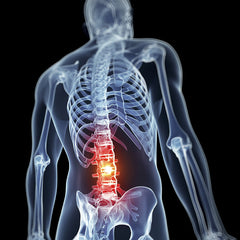Posture Tips Facts

Sitting is killing us—and it’s no wonder.
With all of the computers, tablets, and phones our society is inundated with, we’re sitting more and more. In fact, researchers estimate that by the end of our lifetimes, we will have spent about 31 years sitting.
Among increasing the risk of heart disease, cancer and diabetes, sitting—especially with bad posture—leads to back pain. The problem is: we all sit. Whether we’re sitting at the office, during our daily commute or on an airplane, sitting cannot be avoided. The good news is that learning how to sit and move throughout life with good posture will help eliminate many of the health concerns sitting causes.
Posture Facts
Why You Should Sit Up Straight
Research has shown that good posture has a host of health benefits, some of which include better balance, higher energy levels and a decrease in stress. Good posture has also been shown to relieve and prevent the majority of the back pain eight out of ten Americans will experience at some point during their lives.




- Developing core strength and ensuring proper posture often prevents the majority of back pain (Mayo Clinic (11 Sept. 2012). Prevention. Retrieved from http://www.mayoclinic.com/health/back-pain/DS00171/DSECTION=prevention)
- Proper posture has been shown to encourage healthy breathing, fight pain and inflammation, and increase confidence. (Cuddy, Amy J.C., Caroline A. Wilmuth, and Dana R. Carney. "The Benefit of Power Posing Before a High-Stakes Social Evaluation." Harvard Business School Working Paper, No. 13-027, September 2012.)
- Bad posture can compress blood vessels, increase stress levels and make you feel more tired. (Noe Pagan, C. Don’t Be a Slouch: The Health Benefits of Good Posture. Sept 2010. Retrieved from http://www.lhj.com/health/news/health-benefits-of-good-posture/)
Health Benefits of Good Posture
Balance. One out of three adults (aged 65+) falls each year—and we’re paying for it. In fact, non-fatal fall-related injuries cost about $19 billion each year. Improving posture and balance will help strengthen weak muscles in the back, core, hips and legs which will increase mobility and limit the risk of falling.

Energy Levels. Posture has an important impact on lung capacity. When you slump, you compact your lungs and cannot breathe fully. Unfortunately, less oxygen means less energy, making it nearly impossible to keep on top of your endless to-do list.
Confidence. Your posture affects how you see yourself as well as how others see you. Picture yourself in a big job interview slumped down and slouching in your chair. How do you think your interviewer perceives you? They most likely will find you less confident and, therefore, incapable of doing the job.
Not only does posture make you appear more confident, it actually makes you act more confident. Research shows that when you sit (or stand) with good posture, you increase testosterone and decrease the stress hormone, cortisol.
Stress. Did you know stress is responsible for over 85% of the reasons we go and see our healthcare providers? The good news is that some stress can be prevented with good posture.
When you sit with poor posture, your diaphragm constricts, making it much more difficult to breathe. This reduces the flow of blood and oxygen to your brain which sometimes clouds judgment and makes it easier to feel stressed.
Pain can also be a great contributor to the stress that people feel. Sitting with good posture will help prevent lower back pain, keep inflammation in check and combat stress.

Aging. Experts agree that our posture may be a key indicator of how well we will age. As we age, we usually begin to stoop lower and lower to the ground—oftentimes because our bodies become less flexible and agile, making it difficult to hold ourselves erect.
The important thing to remember is to stay active. As we age, we may begin to avoid movement all-together because we think we’ll be in pain or discomfort. Sometimes that’s only a limitation we put on ourselves. Work towards strengthening posture now and you’ll notice improved balance, coordination and function later on in life.
Athletic Performance. It’s important for the body to work at maximum efficiency during all athletic activities, and unfortunately, if parts of your body are not aligned, you will not perform the way you should or may get easily injured. Because correct posture is different for each activity (ie. weight-lifting vs. running), it’s important to learn and practice the correct form for each sport you participate in.
Additionally, good posture allows muscles to work more efficiently, allowing the body to use less energy and, therefore, prevent muscle fatigue.

Weight. Standing up straight can make you appear ten pounds thinner. How? When you slouch or slump, you appear shorter and you push your belly outwards, making it appear several inches wider than it actually is. When you stand with good posture, you stand tall with your shoulders back and you engage the transverse abdominals, which whittles the waist.
In addition to looking thinner, experts say that those who practice good posture have more energy to exercise and psychologically feel better (both of which allow you to properly manage your waistline).
Increased Productivity. Studies have found expansive postures (in which the body is more opened up—hands are on the hips, feet are on the desk or sitting up straight) increase testosterone levels and decrease cortisol levels, leading to higher confidence and the willingness to approach hard tasks and get them done. Postures in which the body is contracted, slouching or hunching has the opposite effect.
How the Back Works
 To understand why you should have good posture and how to achieve good posture, it’s important to have a basic understanding of the spine and how it works.
To understand why you should have good posture and how to achieve good posture, it’s important to have a basic understanding of the spine and how it works.
Your back is made up of a complex structure of muscles, ligaments, vertebrae, discs and nerves. Each of these elements works together to help you function and move, but because it is so complex, there is a lot within the structure that has the potential to go wrong. Most problems stem from the lower back because it supports the greatest amount of your body’s weight.
Posture is defined by how the body’s structure works together. When one of the parts in the back’s structure is not working or functioning correctly, this can lead to injury and pain. The body may be forced to compensate for and adapt to the pain or malfunction, restricting the natural motion of the spine and ultimately leading to posture problems.
To go from poor posture to good posture is not always a “quick fix”, but with some work, patience and diligence, good posture can be achieved.